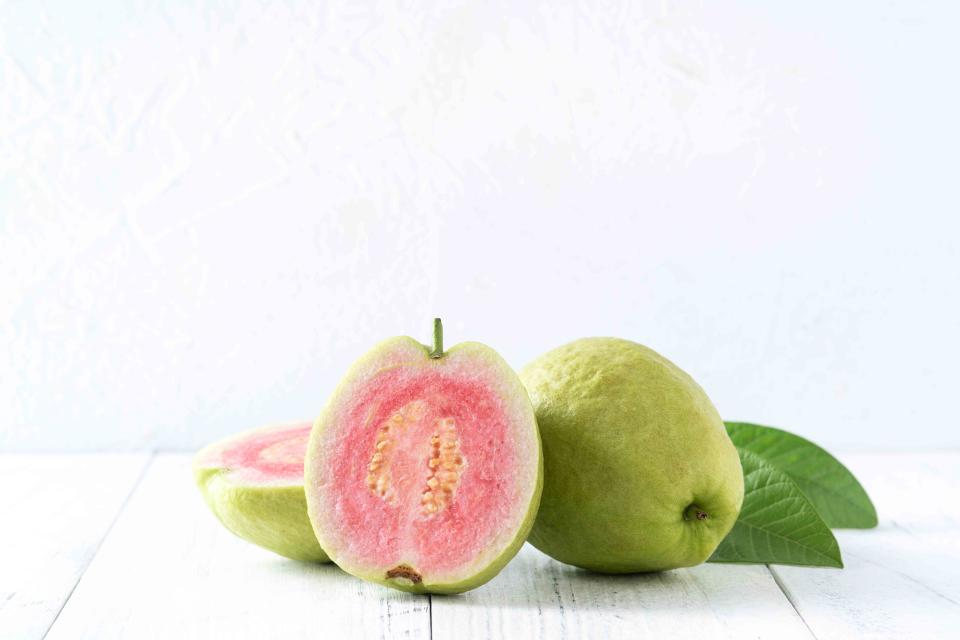How to Eat Guava, the Fruit That Tastes Like a Cross Between Pineapple and Strawberry
Find out how to buy, cut, and enjoy this sweet, fragrant treat.

Getty Images
If you're lucky enough to find fresh guavas at your grocery store, you might wonder how to eat the fruit. In general, they're an uncommon ingredient in the U.S., as they primarily grow and thrive in tropical countries. However, eating and using guava is delightfully simple, making it easy to enjoy its pineapple-strawberry flavor and pulpy texture. Ahead, we spoke to chefs about how to select and eat guava.
Meet Our Expert
Richard LaMarita, chef-instructor of plant-based culinary arts at the Institute of Culinary Education in New York City.
Martha Brahm, chef and founder of Hawaiian Tart Company and Big Island Private Chef in Hawaii.
Related: The Best Ways to Eat Passion Fruit
What Is Guava?
Guava is a tropical fruit native to Central America, South America, and Mexico. It's part of the Myrtaceae (myrtle) family, which includes plants like cloves, allspice, and eucalyptus. The fruit, which is technically a berry, grows on shrubs or small trees. It can have an oval-round or pear shape, depending on the variety.
Flavor: Guava is an aromatic fruit with a flavor that's often described as being like a tangy cross between a pear and a strawberry or a combination of pineapple and strawberry,
Types of Guava
The fruit is available in about 400 varieties, according to the International Society for Horticultural Sciences. Generally, guavas are divided into the following categories:
Pink guava: This variety has pink or red flesh and is eaten when ripe. The apple guava, the most common type found in stores, is a variety of pink guava.
White guava: These are less common in the U.S. and have white flesh. They are eaten when unripe. Examples include Thai guava and Mexican white guava.
How to Pick a Ripe Guava
When shopping for ripe guavas at the grocery store, there are certain signs to look for. A ripe guava will have some give when you squeeze it, says Richard LaMarita, chef-instructor of plant-based culinary arts at the Institute of Culinary Education. The peel will be light green, yellow-green, or green with a hint of rose or pink, and the fruit will have a strong, sweet, and musky aroma, adds LaMarita.
Unripe guavas are very green, firm, and hard to squeeze, so avoid them unless you plan to ripen the fruit at home (or if they're a variety that's meant to be eaten unripe). Alternatively, overripe guavas will feel mushy and have a bad odor, so leave those fruits behind.
How to Quickly Ripen
If your guava is unripe, keep it on the countertop at room temperature. It will ripen in five to seven days when stored this way, says LaMarita. "If you want to ripen it faster, place [it] inside a paper bag with a banana or apple," he says. These fruits emit ethylene gas, which speeds up the ripening process. Additionally, guavas may be coated in wax, which slows down natural ripening. You can wash off this wax to speed things up, says LaMarita.
Storing Ripe Guavas
Once ripe, guavas should be refrigerated and stored within four days.
How to Cut and Eat Guava
"Ripe guavas are soft and easy to cut; no special equipment is needed," says Martha Brahm, chef and founder of Big Island Private Chef and Hawaiian Tart Company. All you need is a paring knife and a cutting board.
Additionally, both the seeds and skin of guava are edible. The seeds are particularly high in fiber and good for digestion, notes LaMarita. However, they're quite hard and can get stuck in your teeth, says Brahm—so you may wish to remove the seeds first.
Wash the guava under cool running water. Pat dry with a paper towel or clean cloth.
Place the guava on its side on a cutting board. Using a paring knife, cut it in half.
If you don't want to eat the skin, scoop out the flesh with a spoon. Slice the flesh into wedges like an apple. If you want cubes, cut the wedges into smaller pieces.
If you don't want to eat the seeds, scoop out the seeds with a spoon. You can then cut the guava halves into wedges, then eat the flesh and skin, says Brahm.
If you don't want to eat the skin and seeds, scoop out the seeds out of each half, then scoop out the flesh. Cut into wedges or cubes.
Related: How to Pick a Perfect Papaya—Plus Inspired Ways to Enjoy This Delicious Fruit
Other Ways to Eat Guava
As with many fruits, guavas can be used in myriad ways.
Eat guava like an apple: The simplest method is to it them fresh and whole like an apple, says LaMarita.
Use in tropical fruit salads: You can also dice or toss them in tropical-inspired fruit salads, like our tropical-fruit juice salad.
Puree for drinks: Guava is particularly tasty when pureed and added to drinks; blend and strain the fruit to get rid of the seeds, says Brahm. Incorporate the guava puree into juices, margaritas, or smoothies, where it will complement other tropical fruits like pineapple, mango, papaya, and banana.
Use in sauces: Guavas are also high in pectin (a natural thickening substance), making them a great addition to jams and sauces, says LaMarita. Consider adding guava puree to your next barbecue sauce for a fruity touch.
Add the puree to desserts: Swirl the guava puree into cheesecake for a tropical twist on the classic dessert, suggests LaMarita. Or, serve it over ice cream.
Top yogurt and other breakfasts: For a simpler take, serve diced or pureed guava as a topping for yogurt, cottage cheese, or oatmeal.
Read the original article on Martha Stewart.

